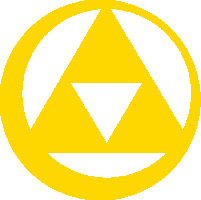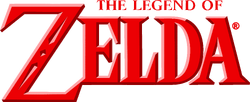The Legend of Zelda: Ocarina of Time Master Quest is a reworked version of the original Ocarina of Time.[1] Master Quest contains largely the same content as the original Ocarina of Time, but with redesigned, more difficult dungeons akin to a Second Quest.
Master Quest was first made available for the Nintendo GameCube on a special bonus disc that also contained the original Ocarina of Time. This disc was given out in limited quantities with pre-orders of The Wind Waker. Additionally, it was sold packaged with The Wind Waker in some regions. It is also available as a mode in Ocarina of Time 3D after first completing the regular game.
Changes from Ocarina of Time[]
The most notable feature of Master Quest is that every dungeon in the game has been modified to increase the difficulty of the game. Each one features a different layout, changing the progression through the levels. Enemies are spread differently throughout the dungeons, and tougher enemies are encountered much earlier on than in Ocarina of Time. In addition, some Gold Skulltula locations in dungeons have been moved, and certain items that are optional in the original version are now mandatory to complete the game.
Both games are emulations, rather than direct ports to the GameCube, and are displayed at an increased 640×480 resolution compared to the 320×240 of the Nintendo 64 versions.
Ocarina of Time 3D Version[]

The Master Quest for Ocarina of Time 3D has been completely mirrored
Master Quest for Ocarina of Time 3D is not available from the start. To unlock it, the main quest has to be completed first.[2] Upon doing so, the player will have an option to choose between the Main Quest or the Master Quest after starting up the game, allowing a second playthrough of the game with redesigned dungeons.
This version of the Master Quest has two significant changes. The entire game has been mirrored, similarly to Twilight Princess for the Wii, making Link right-handed as well as flipping the entire overworld map and the dungeons.[3] In addition to the game being mirrored, all of the enemies and bosses will cause twice as much damage to Link, which also applies to the Master Quest's own Boss Challenge version.[4]
Additional Content[]
The disc also includes preview trailers for then-upcoming games for the GameCube and Game Boy Advance. The selection of trailers differ by region, with Japan having more trailers from different companies and promoting the "Capcom Five". The A Link to the Past & Four Swords trailer is also different, having narration and focusing more on the Four Swords in the Japanese trailer.
Europe and North America
- The Wind Waker
- A Link to the Past & Four Swords
- Metroid Prime
- F-Zero GX
- 1080° Avalanche
- Wario World
- Hot Clips (montage of footage from various games)
Japan
- Mario Party 4
- Resident Evil Zero
- Ultimate Muscle: Legends vs. New Generation
- Mr. Driller: Drill Land
- F-Zero GX
- Resident Evil 4
- Dead Phoenix
- Viewtiful Joe
- P.N.03
- Killer7
- A Link to the Past & Four Swords
- Final Fantasy Tactics Advance
Australia
- Metroid Prime
- Hot Clips (montage of footage from various games)
- A Link to the Past & Four Swords
Korea
History[]
In the late 1990s, Nintendo developed an add-on peripheral for the Nintendo 64 called the Nintendo 64DD. The Nintendo 64DD used magnetic disks, with a larger memory capacity than the cartridges used for the Nintendo 64, allowing for additional content and improved models and textures. While Nintendo hoped that the Nintendo 64DD would attract third-party developers, they also began developing several first-party titles, one of which was Ocarina of Time. Struggling to attract interest to the platform, Nintendo moved development of Ocarina of Time to the Nintendo 64, which was ultimately released on a cartridge.[5] At the time of this change, the game featured more content than the cartridges could hold and so parts of the game had to be removed.[5][6]

An Ocarina of Time save file that has been marked as a "Disk" save, as denoted by the icon on the right side of the screen.
Shigeru Miyamoto announced that an expansion would follow Ocarina of Time, tentatively known as Ura Zelda. The expansion was purpoted to include rearranged dungeons from the original game. The Nintendo 64DD became a commercial failure in Japan, and so most of Nintendo's planned titles for the 64DD, including Ura Zelda, were never released. Miyamoto insisted that the game would continue to be developed, and in August 2000 indicated that Ura Zelda had been completed for some time.[7] Despite this, Nintendo could not decide on how to release the game, and considered different methods such as a magazine tie-in.[8]
Remnants of Ura Zelda's 64DD origins still remain in Ocarina of Time. Several error messages exist in the game's data regarding wrong disks being inserted. A "Disk" tag can also be made to appear in the title screen by modifying the RAM addresses of the game. A save file can also be flagged as a "Disk" save and a "Disk" icon will appear next to the save file on the file select screen. The file will be permanently grayed out and inaccessible, unless the game is tricked into thinking the expansion disk is inserted. Attempting to open the file afterwards will crash the game, presumably due to the game trying to load non-existent files.[9]
Listings[]
Glitches[]
Nomenclature[]
| Language | Name | Meaning | |
|---|---|---|---|
| Japanese | ゼルダの伝説 時のオカリナ 裏 (Zeruda no Densetsu Toki no Okarina Ura) (OoT) ゼルダの伝説 時のオカリナGC 裏 (Zeruda no Densetsu Toki no Okarina Jī Shī Ura) (OoT) | The Legend of Zelda: Ocarina of Time Flip-Side The Legend of Zelda: Ocarina of Time GC Flip-Side | |
| This table was generated using translation pages. To request an addition, please contact a staff member with a reference. | |||
Gallery[]
References
- ↑ The Legend of Zelda: Ocarina of Time 3D — Prima Official Game Guide, Prima Games, pg. 2
- ↑ "The Master Quest will not be available from the start of the game. You will need to play through and complete the main quest first. Once you’ve done so, the Master Quest will then be unlocked. At that point, once you start up your Nintendo 3DS, you will have an option to play the Main Quest or the Master Quest. Additionally, the Boss Replay Challenge (more about this in the next news post), has its own Master Quest version, allowing you to battle these bosses on the tougher difficulty settings." — [1], Zelda Dungeon.net; retrieved May 12, 2011.
- ↑ "For the 3DS remake, the Master Quest has two significant changes. First off, the entire game is now mirrored! That’s right, the entire game has received a complete reflection much like Twilight Princess did for the Nintendo Wii. This means that Link will now be right-handed, the entire overworld map will be flipped, along with all of the dungeons. So Kakariko Village will now be to the West of Hyrule Castle, Lake Hylia will be to the Southeast, and the Desert Colossus at the far northeast corner of the overworld." — [2], Zelda Dungeon.net; retrieved May 12, 2011.
- ↑ "In addition to the game being mirrored, the Master Quest is now significantly harder as difficulty adjusters have been put in, causing all enemies to do double the amount of damage each time they hit Link. [...] Additionally, the Boss Replay Challenge (more about this in the next news post), has its own Master Quest version, allowing you to battle these bosses on the tougher difficulty settings." — Ocarina of Time 3D: Uber Master Quest; retrieved May 12, 2011, Zelda Dungeon.net.
- ↑ 5.0 5.1 "N64.com's Japanese correspondent today confirmed that a complete and finished cartridge-based version of The Legend of Zelda (a working title) will arrive Nintendo 64 late this year, followed by a 64DD afterward. The long-awaited action-based RPG, which many people believed to be the sole killer-app for 64DD, is likely to have a bigger ROM size than Super Mario 64, and is believed to contain as much as 12 MBs." — Zelda officially goes to cart, IGN, published 1997-03-07, retrieved 2013-01-27.
- ↑ "There were several ideas that I could not incorporate [in the current game] because of the time shortage and other reasons. In the future, I want some new areas and new dungeons to be available for players who have already finished Ocarina of Time, where they will find new challenges." — Zelda DD: The Other Adventure, IGN, published 1998-11-17, retrieved 2013-01-27.
- ↑ "Speaking to the press in an open forum held yesterday in Tokyo, Japan, Nintendo's Shigeru Miyamoto casually commented that "Ura-Zelda" has been completed for some time now." — Ura Zelda Complete, IGN, published 2000-08-25, retrieved 2020-08-05.
- ↑ "Although we did develop Ura for the 64DD, it didn't use many of the special features. So it was very easy to port over to the GameCube without cutting any features. Why we did it, well that was because the 64DD was only released in Japan and it was only sold to subscribers of the RandNet system. For a long time we wanted to make it available for play and find a way to do that. It was expensive to make cartridges, so we had through about different ways. One thing we thought about was tie-ups with magazines. Once GameCube moved to disc media, though, it became much more feasible to make it available. In terms of how we've done it, we didn't want to make it limited edition. So we've tried to make it available to as many people as possible." — Miyamoto and Aonuma on Zelda, IGN, published 2002-12-04, retrieved 2013-01-27.
- ↑ https://tcrf.net/The_Legend_of_Zelda:_Ocarina_of_Time#Ura_Zelda_Leftovers




